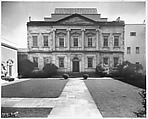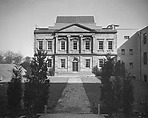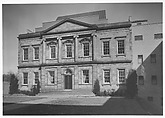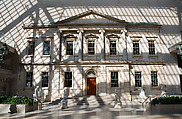Facade of the Second Branch Bank of the United States
Architect Martin Euclid Thompson American
Thompson was a leading exponent of Greek Revival-style architecture in New York during the first half of the nineteenth century. Here, however, in his earliest known design, the Greek influence in minimal. The two-story, seven-bay facade of the Branch Bank of the United States, its projecting center section capped by a pediment, directly followed in the mid-eighteenth-century English Palladian tradition. Only the Ionic capitals and some of the cornice moldings are of Greek inspiration. The building was located on the north side of Wall Street, between Nassau and William streets, and in the 1850s, it was converted into the United States Assay Office. It was demolished in 1915, but the facade was saved and reconstructed as the front of the Museum's American Wing in 1924.
Due to rights restrictions, this image cannot be enlarged, viewed at full screen, or downloaded.
This artwork is meant to be viewed from right to left. Scroll left to view more.





